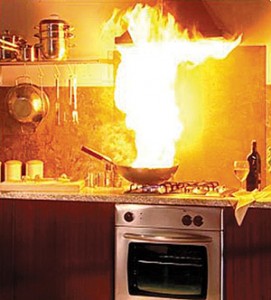By Mike DeMars – Fire Inspector, Central Fire Protection District

Take Care in the Kitchen
The cooking area should be used for cooking only. Keep excess clutter off of your stove and counter tops. Paper, food packaging, dishtowels and other combustible materials should be kept clear of the stovetop. Do not allow pets on counters where hot items could be spilled. Children should not be allowed to play in the kitchen. Identify a safe zone of at least three feet around all cooking appliances. Try to use the rear burners if possible when children are present. Do not hold a child in your harms while you are trying to handle hot food or liquids.
Keep it Clean
When cooking, keep the area clean and clear of hazards. Clean up spills on the stove and clean the oven regularly. Built up grease can contribute to fire. Turn handles of pots and pans in and away to prevent spills. Spilled hot food or liquids can cause serious burns. Do not wear loose clothing when cooking. Loose clothing can come in contact with hot surfaces and burn. If your clothing catches fire while cooking, remember to “Stop, Drop and Roll” until the fire is out. Never leave food cooking unattended on the stove. Turn the stove off if you have to leave the kitchen even for a short period. Remember to “Watch What You Heat.” Never leave the house with food cooking in the oven. Use kitchen timers, when using the oven, to remind you that food is cooking. Don’t cook if you are tired, under the influence of alcohol or taking medication that can make you drowsy.
Careful of Overloads
When using portable kitchen appliances, use only one at a time. Using too many appliances on one electrical circuit may overload the circuit. Plug portable appliances directly into wall outlets. Using extension cords may overheat the appliance. Inspect the cords occasionally for damage. Never place aluminum foil or metal containers in a microwave oven. This can result in a fire. Unplug all portable appliances when they are not being used.
Containing and Extinguishing a Fire
If you have a fire in the kitchen, there are several methods to contain and extinguish the fire. The action you take is dependent on what is burning. If there is a fire in the microwave oven, keep the door closed and turn off the power. The fire will most likely be contained inside of the appliance. Keeping the door closed and turning off the heat source can contain conventional oven fires. Placing a lid on the pot or pan containing the fire can control fires on the stovetop. Keep the lids to pots and pans that you are using on the counter nearby. If food or grease catches fire, carefully place the lid over the pot or pan and turn off the heat. Never try to move a pot or pan with burning food or grease. A fire extinguisher can be used as a secondary means to extinguish a kitchen fire, but use the lid first. Discharging a high-pressure extinguisher on a grease fire may spread it. Never use water to extinguish a kitchen fire. Water can spread a grease fire also. If you have a fire in your home and can’t control it, you should evacuate. “When in doubt, get out.” All fires no matter what the circumstances should be reported to the fire department.
Don’t get Burned
Another hazard associated with cooking is burns. Contact with hot food and liquids can cause serious burns. Use oven mitts and potholders to prevent burning your hands. Make sure that food cools before serving it to children. Cook on rear burners or turn pot handles in to prevent spills. Do not lean directly over the oven door when opening. You may be exposed to steam or superheated air. Microwaved food is often very hot. Open containers slowly away from your face and let them cool before eating. Keep hot food and liquids away from table or counter edges where they can be easily spilled. Minor burns should be cooled with clean water for three to five minutes. More severe burns, when the skin is damaged or blistered, should be treated by a doctor.
Fire and Carbon Monoxide Alarms
In addition to these safety tips, make sure that you have working smoke and carbon monoxide alarms in your home. Make an emergency plan with your family and practice it. Cooking sometimes causes false alarms. Treat all alarm soundings as a potential fire until proven otherwise.